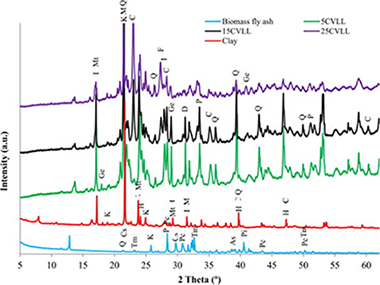Artículos SCI
2018
2018
Propiedades mecánicas, modelización y caracterización de cerámicos avanzados
Grain-boundary diffusion coefficient in alpha-Al2O3 from spark plasma sintering tests: Evidence of collective motion of charge disconnections
Tamura, Y; Zapata-Solvas, E; Moshtaghioun, BM; Gomez-Garcia, D; Dominguez-Rodriguez, ACeramics International, 44 (2018) 19044-19048
Show abstract ▽

The sintering of fine-grained a-alumina by spark plasma sintering (SPS) was performed to study grain growth under SPS conditions. Grain growth is found to be extensive at relative densities above 95%. A grain growth versus dwell time analysis during SPS allows for the determination of the grain-boundary diffusion coefficient. This study shows that the remarkable enhancement of grain-boundary diffusion derived from a previous analysis could be a consequence of the presence of the recently discovered "disconnections" at the grain boundaries of alpha-alumina. Their presence, together with their electric charge and the external electric field at the boundaries, are the key ingredients for a violation of the typical grain growth kinetic law. When they are introduced appropriately, an updated value of the grain-boundary diffusion coefficient is achieved. A comparison with other values reported previously in the literature through other techniques and a critical analysis are also carried out.
Octubre, 2018 | DOI: 10.1016/j.ceramint.2018.07.073
Materiales Avanzados
Biomass fly ash and aluminium industry slags-based geopolymers
Perez-Villarejo, L; Bonet-Martinez, E; Eliche-Quesada, D; Sanchez-Soto, PJ; Rincon-Lopez, JM; Castro-Galiano, EMaterials Letters, 229 (2018) 6-12
Show abstract ▽

Geopolymers are a new class of non-Portland cements produced using an alumino-silicate material and an activating solution, which is mainly composed of sodium or potassium and waterglass to be subsequently cured at relatively low temperatures. Those can be formulated by adding natural minerals, waste and/or industrial by-products. The study investigates the microstructural properties of geopolymers synthesized from metakaolin (MK) and the admixture of fly ash (FBA) and aluminium industry slags (AIS) at different ages of curing. Five different geopolymer compositions were prepared and characterized by XRD, ATR-FTIR and SEM/EDS. The study revealed that geopolymeric gels are identified, which show mainly glassy microstructures, in agreement with the X-ray amorphous diffraction patterns, broad FTIR features and confirmed by SEM/EDS, with promising results prior to an industrial scale.
Octubre, 2018 | DOI: 10.1016/j.matlet.2018.06.100
Reactividad de Sólidos
Mesoporous Silica by Solution-Combustion Synthesis Followed by Etching
Salehtash, F; Jalaly, M; Motejadded Emrooz, HB; Gotor, FJ; Sayagués, MJInternational Journal of Self-Propagating High-Temperature Synthesis, 27 (2018) 221–227
Show abstract ▽
Mesoporous silica was synthesized through the solution-combustion process followed by etching with aqueous solution of sodium dodecyl sulfate (SDS). Combustion products were characterized by XRD, FTIR, SEM, TEM, HRTEM, and BET analysis. After etching, the specific surface, mean pore size, and volume of porous space in silica increased up to 390 m(2)/g, 15 nm, and 1.6 cm(3)/g, respectively. The synthesized mesoporous silica exhibited good performance in the tests on elimination of methylene blue from aqueous solution.
Octubre, 2018 | DOI: 10.3103/S1061386218040064
Spanish and Portuguese Gilding Threads: Characterization Using Microscopic Techniques
Perez-Rodriguez, JL; Albardonedo, A; Robador, MD; Duran, AMicroscopy and Microanalysis, 24 (2018) 574-590
Show abstract ▽
Gilding threads collected from Spanish and Portuguese palaces and from the embroideries and adornments of sculptures of the Virgin and Christ that form part of Sevillian Holy Week were analyzed and compared (20 artifacts were evaluated). The study covered a broad time period with examples from the 13th to 14th centuries, 18th to 20th centuries, and also including modern embroideries. A combination of scanning electron microscopy and energy-dispersive X-ray spectroscopy was used. The knowledge of the layered structures of the threads has provided very valuable information regarding the manufacturing techniques. The different metal threads found in the embroidery studied consisted of gold, silver, copper, and alloys of these metals and aluminium. The fabrication procedures often differed in the different workshops and changed with time. In the modern embroideries, a decrease of precious metal concentration was detected. The threads were wound around a core of silk threads.
Octubre, 2018 | DOI: 10.1017/S1431927618015167
Materiales Avanzados
Manufacture of sustainable clay ceramic composite with composition SiO2-Al2O3-CaO-K2O materials valuing biomass ash from olive pomace
Bonet-Martinez, E; Perez-Villarejo, L; Eliche-Quesada, D; Sanchez-Soto, PJ; Carrasco-Hurtado, B; Castro-Galiano, EMaterials Letters, 229 (2018) 21-25
Show abstract ▽

Fly ash is a biomass combustion by-product produced by dragging ash from the base of the furnace. Disposing of ash is a growing economic and environmental burden. Based on physical and chemical properties, fly ash could be used in the manufacture of construction materials. This paper investigates the influence of biomass fly ash from olive pomace as additive to manufacture of clay ceramic composite materials. Fired clay brick at 950 degrees C were prepared containing between 0 and 25 wt% fly ash. Final products are studied by water absorption, bulk density, loss of ignition, linear shrinkage, compressive strength and physisorption N-2. The results reveal that the porosity of the materials increases with the level of fly ash replacement (10% up to 25 wt%) resulting in to increased water absorption and decreased compressive strength. Fired clay brick developed in this study can be used for construction materials based on criteria of the current regulations.
Octubre, 2018 | DOI: 10.1016/j.matlet.2018.06.105
- ‹ anterior
- 153 of 420
- siguiente ›














